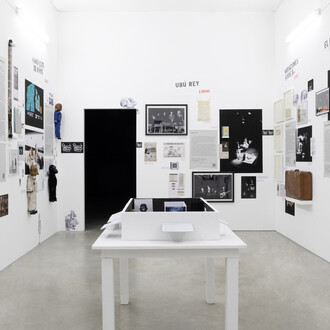Whoever reveals the process does so because they feel, because they value each stage in the consolidation of an image as autonomous. This is not only useful to the artist, who is thinking as they work, but also to the viewer, who contemplates the outcome. Each partial result offers clues about what comes next. Collages, wire reliefs, plasters, ceramics, and finally bronzes: this is the multidimensional path that matter suggests to Fabio Miniotti. Several ideas underlie each step, which, as described, evolves from the plane to the volume. But creation is not linear, it evokes a system of communicating vessels, where overflow leads to a new path, a parallel solution that does not exclude the previous one.
Drawings in the air, the reliefs trace a figure that defies the static orthogonality of historical constructivism. Trapezoids, ellipses, and deltoids break with the positional balance of rectangles and squares. Once they become bodies, the tension created by a side that curves and narrows a radius is only balanced by lines that seem to support the form. But they do not support it, they merely complete it from within, leaving gaps of emptiness, other figures from an invented structure with no logic other than gesture and visual counterweight.
The plasters conceal these structures with layer upon layer of fabric soaked in plaster. They define an external shape that absorbs geometry, becoming organic and, as in the human body, its largest organ: the skin. The sculpture’s skin bears and expresses the entire past of the work, its skeleton and the imprint of modeling. In its bronze state, the piece becomes even more sophisticated. It displays its qualities mediated by an absolute present: the final patina, textures, pores, cavities, that this fine veil worked with acids and oils reveals or conceals. Impressionism taught us to explore the nature of light upon the skin of objects. Thus, deep black bronzes draw the eye inward along every inch of a modulated surface, the flesh of the sculptural bone. Unexpectedly, a small perpendicular plane reflects and captures sunlight in the material, revealing contrasts between smoothness and roughness, the opposites that connect sight and touch. The haptic quality of Miniotti’s work celebrates sculpture’s true essence: being a symbolic body offered to a real body.
Fossilized bones, petrified woods, pebbles rounded by water, many are the images, all alluding to a primordial nature shaped by time, where geometry subtly pulses beneath the skin.
(Text by María José Herrera, curator)







![Various artists, Tramoya [Stagecraft], exhibition view. Courtesy of Museo de Arte Moderno de Buenos Aires](http://media.meer.com/attachments/7b634d843c1effc76d8d97ac251e63a3ca21b283/store/fill/330/330/4e1ca5a8881d5780a8ebcddde81382609430ae6a59e4505a831583cc0ea1/Various-artists-Tramoya-Stagecraft-exhibition-view-Courtesy-of-Museo-de-Arte-Moderno-de-Buenos.jpg)






